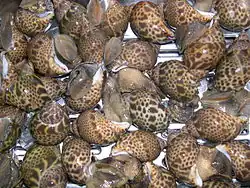貝
| ||||||||
| ||||||||
Translingual
| Stroke order | |||
|---|---|---|---|
| Stroke order | |||
|---|---|---|---|
 | |||
Han character
貝 (Kangxi radical 154, 貝+0, 7 strokes, cangjie input 月山金 (BUC), four-corner 60800, composition ⿱目八)
- Kangxi radical #154, ⾙.
Derived characters
- Appendix:Chinese radical/貝
- 𰂇, 唄, 垻, 㛝, 孭, 𫸳, 𭜼, 𢭲, 浿, 狽, 䢙, 𣇜, 梖, 𪸭, 㸽, 珼, 𬒹, 𥆘, 𦁀, 蛽, 𧧾, 𧳒, 𧼀, 䟺, 鋇, 𩗗, 鼰
- 則, 郥, 戝, 敗, 㲘, 𨿎, 鵙, 𪔡, 𠭁, 𬹠, 頁, 員, 𦮷, 𭶰, 𪽾, 𥦎, 筫, 𡪛, 𮦒, 䩀, 𦺲, 𫂢, 𥴶, 𥴹, 寶, 𧂟, 𫴩, 𠩠, 屓, 𬟫, 𢊾, 𪊾, 閴, 齎
References
- KangXi: page 1204, character 1
- Dai Kanwa Jiten: character 36656
- Dae Jaweon: page 1665, character 2
- Hanyu Da Zidian (first edition): volume 6, page 3622, character 1
- Unihan data for U+8C9D
Chinese
| trad. | 貝 | |
|---|---|---|
| simp. | 贝 | |
Glyph origin
| Historical forms of the character 貝 | ||||
|---|---|---|---|---|
| Shang | Western Zhou | Warring States | Shuowen Jiezi (compiled in Han) | Liushutong (compiled in Ming) |
| Oracle bone script | Bronze inscriptions | Chu slip and silk script | Small seal script | Transcribed ancient scripts |
 |  |  |  |  |
| Old Chinese | |
|---|---|
| 貝 | *paːds |
| 狽 | *paːds |
| 鋇 | *paːds |
| 浿 | *pʰaːds, *pʰreːds |
| 垻 | *praːs |
| 敗 | *praːds, *braːds |
| 唄 | *braːds |
Pictogram (象形) – cowry.
Etymology
Cowries were used as money in ancient China (shell money). Guo (1945) proposes that cowries used by the ancient Chinese dynasties in Central China must have come from the southeastern shores of China and areas further south, as the species of sea snail used as decoration and currency—Monetaria moneta (money cowry)—is not native to the eastern seashores of China. He further proposes that in addition to the cowry itself, the word for cowry, 貝, is also an ancient loanword from languages of the south (which call it “bia”).
Compare Malay bia (“cowry”), Thai เบี้ย (bîia, “cowry shell; money”), Proto-Mon-Khmer *ɓa(a)j (“bean, small weight or coin”) > Khasi sbâi, 'bâi (“money, cowry, shell”), Khmer ពៃ (pɨy, “obsolete small coin”).
Alternatively, Starostin, Matisoff (2003) and Schuessler (2007) relate 貝 to Proto-Sino-Tibetan *bwap (“snail”), via 貝 (OC *paːds) < *pāps. If so it would be cognate with Jingpho pawp, lapawp (“snail”).
Pronunciation
Definitions
貝
- shellfish; cowrie
- † money; currency
- a surname
- 貝聿銘/贝聿铭 ― Bèi Yùmíng ― Ieoh Ming Pei (Chinese-American architect)
Compounds
|
|
|
Japanese
Kanji
(grade 1 “Kyōiku” kanji)
Readings
- Go-on: はい (hai)
- Kan-on: はい (hai)
- Kan’yō-on: ばい (bai)
- Kun: かい (kai, 貝, Jōyō)←かひ (kafi, historical)
Etymology 1
| Kanji in this term |
|---|
| 貝 |
| かい Grade: 1 |
| kun’yomi |

/*kapi1/ → /kaɸi/ → /kawi/ → /kai/
From Old Japanese.[1] Found in the Man'yōshū, completed some time after 759 CE.[2]
Pronunciation
- (Tokyo) かい [káꜜì] (Atamadaka – [1])[3][4][5]
- IPA(key): [ka̠i]
Noun
貝 • (kai) ←かひ (kafi)?
- [from 759] an aquatic shellfish (generally limited to mollusks with calcareous shells such as clams or snails, and excluding crustaceans such as shrimp or crabs)
Derived terms
- 貝殻 (kaigara, “shell, seashell”)
- 一枚貝 (ichimaigai, “univalve”)
- 貝合わせ (kaiawase, “tribadism”)
- 二枚貝 (nimaigai, “bivalve”)
- 帆立貝 (hotategai, “scallop”)
Etymology 2
| Kanji in this term |
|---|
| 貝 |
| ばい Grade: 1 |
| kan’yōon |
| Alternative spellings |
|---|
| 蛽 海蠃 (rare) 海螄 (rare) |

Probably ultimately from Middle Chinese 貝 (MC pɑiH). Compare modern Min Nan pronunciation buê6, Cantonese bui3, Mandarin bèi.
First attested in 1284.[6]
Pronunciation
- (Tokyo) ばい [báꜜì] (Atamadaka – [1])[3]
- IPA(key): [ba̠i]
Noun
貝 • (bai) ←ばい (bai)?
- [from 1284] Babylonia japonica: the Japanese babylon or Japanese ivory shell
Usage notes
- As with many terms that name organisms, this term is often spelled in katakana, especially in biological contexts (where katakana is customary).
References
- 1988, 国語大辞典(新装版) (Kokugo Dai Jiten, Revised Edition) (in Japanese), Tōkyō: Shogakukan
- c. 759, Man'yōshū (book 15, poem 3709), text here
- 2006, 大辞林 (Daijirin), Third Edition (in Japanese), Tōkyō: Sanseidō, →ISBN
- 1998, NHK日本語発音アクセント辞典 (NHK Japanese Pronunciation Accent Dictionary) (in Japanese), Tōkyō: NHK, →ISBN
- 1974, 新明解国語辞典 (Shin Meikai Kokugo Jiten), Second Edition (in Japanese), Tōkyō: Sanseidō
- “貝・蛽・海蠃”, in 日本国語大辞典 (Nihon Kokugo Daijiten, “Nihon Kokugo Daijiten”) (in Japanese), 2nd edition, Tōkyō: Shogakukan, 2000, →ISBN
Korean
Hanja
貝 (eumhun 조개 패 (jogae pae))
- Hanja form? of 패 (“clam, shellfish”).
Vietnamese
Han character
貝: Hán Nôm readings: bối, buổi, bói, búi, với, mấy, mới, vuối, thói
- This term needs a translation to English. Please help out and add a translation, then remove the text
{{rfdef}}.